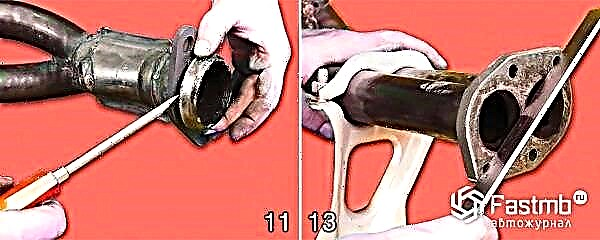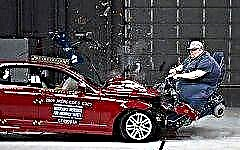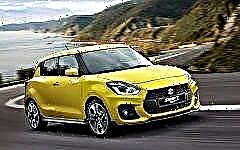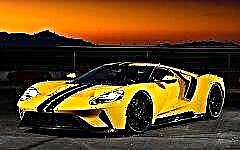

The content of the article:
- Generation BMW M5
The BMW M5, the legendary high-performance business super sedan, has been delighting car enthusiasts for thirty years, constantly updating and keeping up with the spirit of the times. During its existence, it has gone through five generations, remaining stylish, reliable and comfortable.
Generation BMW M5
First generation. BMW E 12 (1972-1983)

The history of the first M5 sedan begins with the presentation of the car in the back of the E 12 at the 1979 Frankfurt Motor Show.
It was a very stripped-down version of the car in the M5 lineup, but innovations and technically superior solutions from the division of the M GmbH concern, even in this case, turned out to be enough.
A simple "working" sedan was equipped with an atmospheric M30 engine with six cylinders and a volume of 3.5 liters. Such power units were installed only on advanced 7-series sedans and 6-series coupes.
The Bosch L-Jetronic injection system allowed the car to develop an output of 218 hp. at 5200 rpm. Complete with a non-weak engine, there was a five-speed manual transmission, thrust was supplied to the rear drive wheels.
To accelerate to the test hundred, the car took only 7.2 seconds. The M535i was equipped with disc brakes, but featured improved shock absorbers and redesigned springs.
For the European market, all cars were assembled at a car plant in Germany, and for markets on other continents, assembly was carried out from ready-made kits at local facilities. It was at this moment that the history of the car, which became the benchmark for sports sedans, begins.
Second generation. BMW E 28 (1984-1988)

The blurred line between generations sometimes leads to confusion. The second generation, which acquired more pronounced sports features in appearance, went on sale in 1985, and the first sedan of this series has already "lit up" at the 1984 Amsterdam salon, intriguing visitors.
The "charged" version of the production car E28 turned out to be quite large - with a total weight of 1550 kg, it was 4620 mm long and 1699 mm wide.
The engine was installed in the car similar to that which was included in the package of the progenitor version with the only difference - the power was "overclocked" to 286 hp. Otherwise, there was a manual transmission with five gears and a fully independent suspension.
The acceleration speed became faster, making 6.1 seconds, while the maximum speed reached 250 km / h. The handling of the car seemed flawless! According to the test results, the car of the first generation became the fastest among the serial sedans of the world automakers.
At first, simple production cars with an engine of 218 hp were produced. and gaining speed in 7.2 seconds. These were the same figures as that of its predecessor, the BMW M535i. The maximum speed reached 230 km / h.
But after some time after the release, an alternative to the five-speed manual transmission appeared - the "automatic" - four-band ZF, which can work in three modes. It offered a sporty driving mode as well as manual and winter.
The previous model retains thicker anti-roll bars for lateral stability, shortened springs and retuned shock absorbers. The braking system has acquired an anti-lock function.
The interior of the car has acquired a more expensive and presentable look. Cars in the E 12 and E 28 bodies were equipped with sports-style seats with thoughtful side support, an additional cushion in the back, a three-spoke steering wheel, a gear lever developed specifically for BMW and linings with the concern's logo.
Based on the wishes of the buyers, the cars were equipped with any seats - soft or, conversely, hard ones from Recaro.
During the production of the first generation model, 2,191 cars rolled off the assembly line.
Third generation. BMW E 34 (1988-1995)

The new generation, which rolled off the assembly line in Garching, slightly increased in size: the car became heavier (1670 kg) and longer (4710 mm), remaining strict and aggressively sporty, symbolizing a symbol of prestige.
The interior has become more thoughtful, more like a cockpit, allowing the driver to fully concentrate on driving. German restraint was felt in everything, all the details in the cabin were comfortable and refined, focusing primarily on the convenience of the driver.
In terms of build quality, the E 34 sedans were head and shoulders above their constant competitor Mercedes-Benz.
Initially, only sedans with a 3.5-liter engine with a capacity of 315 hp were produced. with a five-speed "mechanics". They accelerated to a hundred in 6.3 seconds, with a forced speed limit of up to 250 km / h.
Gradually, the line was overgrown with variations, as a result, in the European market there were simultaneously many engines for the "five" for different needs - from economical BMW 518i and sophisticated BMW 540i / BMW M5 to engines running on gas and diesel.
They were all obedient and reliable, with the only caveat that they required only high quality fuel and oil and regular maintenance.
Since 1990, a station wagon variant called Touring has been added to the sedan body.
Being in the luxury segment, the car showed excellent handling, responsive and light steering and responsive suspension.
In addition to the modernization of the engine, various transmission options were available - “mechanics” with 4/5/6 steps.
The fastest among the cars in the back of the E 34 was the Alpina. She took acceleration in 5.4 seconds, the possible speed ceiling for her was set at 290 km / h. This model was released in the amount of 507 copies. The total number of all second-generation cars that rolled off the assembly line was 12,000.
Bavarian engineers tried to create an M-convertible, but work stalled at the stage of creating a concept car, and did not reach the show at the car dealership.
Fourth generation. BMW E 39 (1995-2003)

The next generation of the model was left with only one body option - a sedan station wagon. It was produced at the factory in Dingolfing.
The car has increased the already rather big dimensions. In length, it has grown to 4781 mm, the weight has increased to 1795 kg, while the interior space has also "expanded", corresponding to the status of a luxury car, where you can sit comfortably and freely.
The "sixth" engine, which was successfully operated in the previous generation, was replaced by an advanced aluminum "eight" of a larger volume - 4.9 liters. The "base" S62B50 engine generated 400 hp, accelerating the car in 5.3 seconds.
The set included a six-speed "mechanics", the rear drive axle was equipped with a differential, the front racks were installed from MacPherson strut, the rear traditionally used a multi-link design.
At the turn of the XXI century, BMW E 39 appeared in Russia, assembled at the plant of the Avtotor JSC enterprise (Kaliningrad region).
In 2000, the car underwent a restyling, acquiring original CELIS lighting equipment and more rounded outlines of bumpers and mirrors.
An innovation was the appearance of three engines, which were installed on the 520i / 525i / 530i models. The six-cylinder in-line engines are based on the Double-VANOS system. The strongest powertrain in this series for the 530i is designed for a volume of 3 liters, with 231 hp.
In the combined cycle, the car consumed 14 liters of gasoline per hundred kilometers. Over the years of production of the third generation, 20 thousand BMW E 39 cars have been sold around the world.
Fifth generation. BMW E 60 (2005-2010)

The models were produced in sedan (E 60) and station wagon bodies (E 61). Outwardly, the M5 has acquired a more rounded shape, becoming more catchy. But the salon, on the contrary, has changed not for the better.
Fans of the Bavarian brand expressed negative opinions, pointing to the excessive "Nordic" interior and not too convenient location of the console, turned away from the driver.
The dimensions of the car also grew - the length increased to 4855 mm, the width of the M5 expanded to 1846 mm, the curb weight was already 1846 kg.The model, despite the negative aspects, quickly gained popularity, breaking the sales records of the past generation.
The 4.9-liter V8 was replaced by a high-revving aspirated V10 5.0, developed specifically for the new generation of BMW. This motor produced 507 hp. upon reaching 7750 rpm.
The E 60 cars received high-tech power units under the hood, which are still installed on modern BMW models.
Torque for rear-wheel drive was transmitted thanks to a two-shaft robotic seven-position SMG III transmission. The test acceleration was achieved in 4.7 seconds, the permissible speed was still limited to 250 km / h.
Before production ceased, 19,522 sedans and 1,025 station wagons were produced.
Sixth generation. BMW F 10 (2009-2017)

The model was produced in four types of bodies:
- F 10 - sedan with four doors;
- F 11 - a station wagon with five doors, known as the Touring;
- F 07 - fastback with five doors, which became popular under the name Gran Turismo;
- The F 18 is a four-door sedan with an "grown" wheelbase, produced specifically for the Middle East, Chinese and Mexican markets.
A fastback body with a sloping roof that seamlessly merges into the luggage compartment lid was implemented for the first time for BMW. The chassis has undergone major modernization.
The design of the car remained within the framework of the corporate style of BMW - the engineers preferred to abandon all the dissatisfied fans, innovations
The 7 Series F 01 served as the platform, so the overall car is wider, lower and longer. Not only rear-wheel drive classics of the concern, but also all-wheel drive models, began to be offered for sale.
The range of engines has increased - there are seven modifications of them, of which four run on gasoline (4.4 or 2-liter with a power spread of 234 and 184 hp) and three - on diesel (2-liter or 3 liter with a capacity of 313/258 hp).
For convenience, several transmissions are offered to choose from: Steptronic automatic with 8 steps, six-speed "mechanics" and "automatic" of the sport type with various driving possibilities - from dynamic to economical.
The developments of BMW engineers are developing more and more effective passenger protection, which is greatly facilitated by airbags and side backbags, curtains, dynamic stability systems, preventive safety, easy cornering, efficient cruise control, parking assistant and course crossing warning.
In the sixth generation, the interior is distinguished by its luxurious design, optimal size ratio, amazing maneuverability and economy.
Celebrating its 30th anniversary, BMW has released a special version of the 30 Jahre M5 with a capacity of 600 hp, which is by far the most "pumped" car in the history of BMW.
The limited edition is 300 pieces. The supercar accelerates in 4 seconds and reaches 305 km / h. The interior of the car has undergone dramatic changes - chrome, aluminum, alcantara create a space of luxury and comfort.
Seventh generation. BMW G 30 (2017-present)

Announced in 2016, the new BMW 5 Series has been in production since 2017. The assembly is carried out at factories in Germany (Dingolfing) and Austria (Graz). Models are available with three bodies:
- G 30 - sedan with four doors;
- G 31 - station wagon five-door;
- The G 38 is a sedan with four doors and an oversized wheelbase.
Technologically, for the seventh generation, it was decided to take the platform from the seventh series of the G 11 generation. At the same time, the development of the car took place without regard to previous versions, which significantly improved both the design and the richness of electronics, and equipment, making the BMW G 30 as comfortable as possible for passengers and the driver.
The concern's plans for the future include the release of hybrids (530e iPerformance), as well as the active introduction of an improved driver assistance system.
Conclusion
The BMW 5 Series Business Sedan has stood the test of time. The company continues to release the model, improving it and making it better, safer and more comfortable from generation to generation.
Bmw











